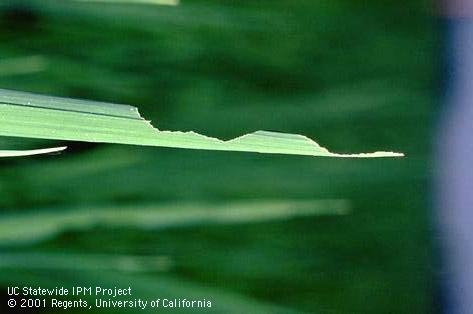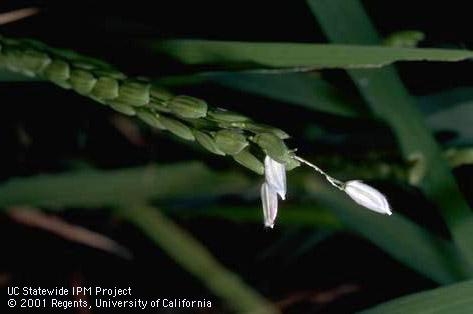I was recently contacted by a PCA who was observing armyworm feeding in Delta rice fields. Over the last two years, both locally and in the Sacramento Valley, armyworms have been striking rice fields earlier in the season and in greater numbers. This has been described by farm advisors in the UC Rice Blog. Armyworms are generally a summer pest of rice, spending spring and early summer months on other plants, but over the last two years, armyworm feeding has been detected in June. Armyworms generally only have one generation in rice later in the season, but last year, earlier infestations caused concern for there to be two generations. This was not generally observed, but PCAs should keep this in mind again this year as they scout throughout the summer.
Armyworm defoliation is most deleterious during stem elongation and grain formation and is observed as angular cut-outs from the leaves (Figure 1). UC IPM guidelines state that yield may be affected if defoliation is greater than 25 percent of the plant at two to three weeks before heading, and they provide the following monitoring instructions.
To sample, choose a part of the field where you have observed injury. Select a plant at random and pull it up or move all the surrounding foliage away and check for defoliation. Check the plant from the top of the leaves to the base of the plant and the water surface for armyworms. Determine if 25% or more of the foliage has been removed by armyworms; also note if you find armyworms on neighboring weeds or rice plants. Record your observations on a monitoring form. Repeat this procedure every 5 to 10 feet across a transect until 10 plants have been examined. Move to a different part of the field where feeding is evident and examine 10 more plants in the same manner. Repeat this procedure at several areas of the field until you are confident that you have an estimate of the average field condition.
It is important to monitor throughout the season in order to detect damage severity, and thus, know when to treat. Later in the season, damage may also occur on the panicle rachis. UC IPM guidelines recommend treatment when, in the vegetative stage, at least half of the plants sampled have at least 25 percent defoliation and armyworms are present. When the panicle has formed, UC IPM guidelines recommend treatment if 10 percent of the sampled panicles are damaged and armyworms are present. Armyworms are generally more apparent at night or in the cooler morning hours; thus, monitoring should occur when worms are active and apparent.
Early season management of armyworms includes weed management around the perimeter of fields. Registered chemicals are limited but include certain pyrethroids, which have not always proven efficacious, and carbaryl, which cannot be used within two weeks of a propanil application. The carbaryl label also includes precautionary language regarding bees, so it would not be recommended when rice is neighbored by insect-pollinated crops, like melons.
This year, the California Department of Pesticide Regulation has issued a crisis exemption under the US EPA Section 18 to allow for the use of Intrepid 2F (methoxyfenozide) on armyworms in certain rice growing counties, including San Joaquin County. The emergency exemption is valid until September 30, 2016. Please contact the county Agricultural Commissioner's office for more details.
Attached Images:

